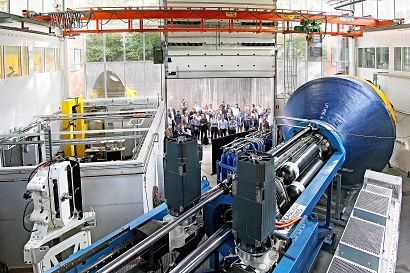
The testing involved the dry testing of CorPower’s power take-off (PTO) on the Hardware-In-the-Loop (HIL) test rig, specifically designed for the purposes of testing the PTO onshore as part of the Wave Energy Scotland (WES) funded Hi-Drive project.
The purpose of the Hardware-In-Loop (HIL) rig is to enable onshore testing and provide verification of WEC machinery subsystems before deployment. The rig emulates loads and motions representative of a complete range of expected sea-states.
As a verification body, EMEC has well-developed method and validation process in place to ensure strict quality management and quality assurance of the verification process. This involves reviewing the test plan and methodologies prior to commencing the tests, witnessing the tests, and reviewing the test report and test data for accuracy and completeness.
The performance statement covers both the PTO and HIL rig performance.
The dry test programme performed over seven months included 708 registered test runs, with 378 signals being measured providing more than 1TB of data on the equipment. Each specified function was tested starting with gentle loading, allowing safety and machine control to be verified while stabilising the operation. Having built confidence at low sea states, the loading was gradually ramped up verifying the performance on the range of operation up to full range storm waves. The innovative WaveSpring phase control method was verified, with sub-system efficiency of 99 percent at rated loading. The test campaign was finalised with a two-week non-interrupt test.
Following the dry tests in Sweden, CorPower’s WEC – named C3 - was transported to Orkney. The half-scale WEC was deployed in January 2018 at EMEC’s scale test site at Scapa Flow in Orkney with support from the Interreg_NWE FORESEA programme.
CorPower intend to wrap up the C3 tests this summer and will incorporate the learning from the wet tests into the development of their next generation WEC technology. This is part of the Horizon 2020 funded project – WaveBoost and the full scale HiWave-5 project.
The HIL-rig will also be used within the WaveBoost project to verify next generation design.
“EMEC were impressed with the dry testing programme undertaken by CorPower as part of their WES project, and has been used to derive lessons learnt and provide enhanced projections of the performance of the next iteration full-scale WEC – the C4” said Elaine Buck, Technical Manager, EMEC.
Patrik Möller, CEO, CorPower, added that the company is delighted with the results of the C3 dry test campaign and model calibration and that it is confident that the full-scale WEC will deliver five times more energy per ton and three times more energy per force compared to current state-of-the-art devices, bringing the structural efficiency of wave energy to a similar level as a modern wind turbine.
Image: HIL rig CorPower S3 Machine call with 500kW HIL-rig and C3 Wave Energy Converter. Credit CorPower
For additional information:

